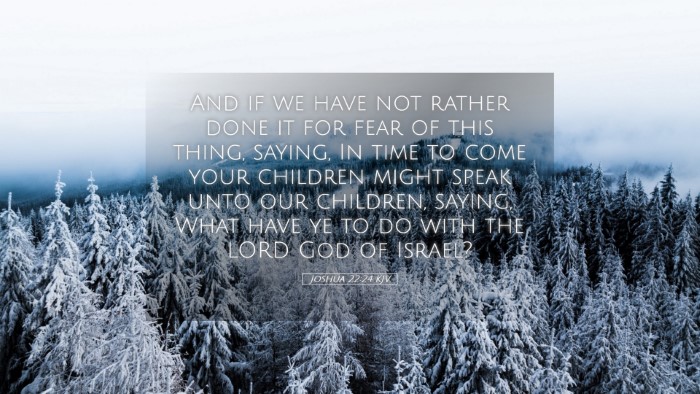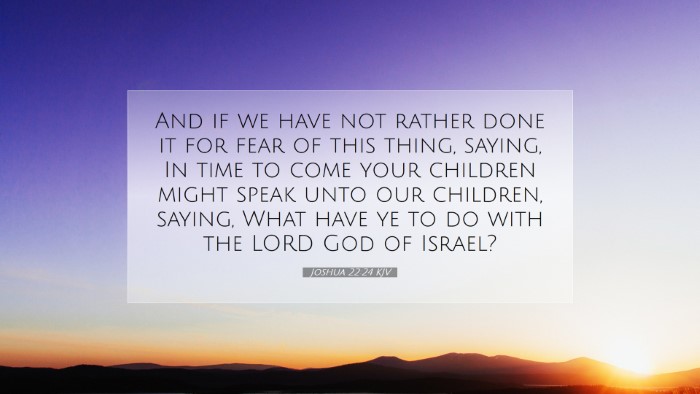Commentary on Joshua 22:24
Joshua 22:24 states: "And if we have not rather done it for fear of this thing, saying, In time to come your children might speak unto our children, saying, What have ye to do with the Lord God of Israel?"
Contextual Overview
This verse comes from a crucial moment in the narrative of Israel's history. The tribes of Reuben, Gad, and half of Manasseh had built an altar at the Jordan River, which raised concerns among the other Israelite tribes that they might be establishing a rival worship center. The ensuing dialogue highlights the themes of unity, identity, and fidelity to God amid potential civil strife.
Commentary Insights
Matthew Henry's Commentary
Matthew Henry emphasizes the importance of motives behind actions. The tribes that built the altar explain they did so not out of rebellion but out of a desire to ensure their descendants would have a tangible reminder of their allegiance to God. Henry points out that the fear of being misunderstood was a significant motivator for their actions. This reflects on the human tendency to seek validation and maintain unity in faith. Furthermore, Henry notes that maintaining a clear identity as God’s people is crucial for the generation that follows.
Albert Barnes' Commentary
Albert Barnes provides a detailed examination of the implications of the tribes’ concerns regarding their familial relationships and communal worship. Barnes highlights that the fear referenced in the verse emanates from the potential disconnection of their children from the shared faith and covenant relationship with God. He also focuses on the thematic relevance of maintaining the unity of worship and emphasizes the necessity for communication and understanding within the community of believers. Barnes concludes that the altar symbolized a bridge to future generations, solidifying their heritage and commitment to God.
Adam Clarke's Commentary
Adam Clarke offers an intricate analysis of the cultural and historical context of the statement made in the verse. He elaborates on the significance of tradition and memory in ancient Israelite culture. Clarke points out that the construction of the altar was not merely for worship but was also a vital educational tool for the future. It was intended to prompt discussions among children about their roots and their relationship with God, thus ensuring a continuous lineage of faith. Clarke argues that this proactive measure reflects wisdom in leadership—foreseeing the implications an action might have for future generations.
Theological Implications
- Fear and Responsibility: The fear expressed by the tribes illustrates a profound sense of responsibility for future generations. Their concern that misunderstandings could arise underscores the importance of clarity in communal faith practices.
- The Role of Symbols: The altar serves as a symbol not only of worship but of identity among the tribes, reminding them of their commitment to God, which transcends generations.
- Unity in Diversity: The call for unity amidst diversity is a reminder for the church today. Just as the tribes maintained their identity while also seeking to connect with the larger Israelite community, the church must foster dialogue and understanding among diverse beliefs.
Pastoral Applications
For pastors, Joshua 22:24 presents opportunities for teaching about the importance of legacy and faith transmission. It encourages leaders to consider how their actions might be interpreted by future generations and how they can guide their communities toward a unified vision of faith. Pastors should foster environments of open communication where questions about faith can be freely discussed, aiming to educate and engage with younger members of the congregation.
Conclusion
Joshua 22:24 serves as a poignant reminder of the complexities of communal faith and the need for foresight in spiritual leadership. The insights drawn from the commentaries of Matthew Henry, Albert Barnes, and Adam Clarke encourage a comprehensive understanding of the responsibilities that come with faith. Ultimately, this verse invites all believers to engage thoughtfully with their heritage of faith, ensuring that future generations are connected to the story of God’s people.


